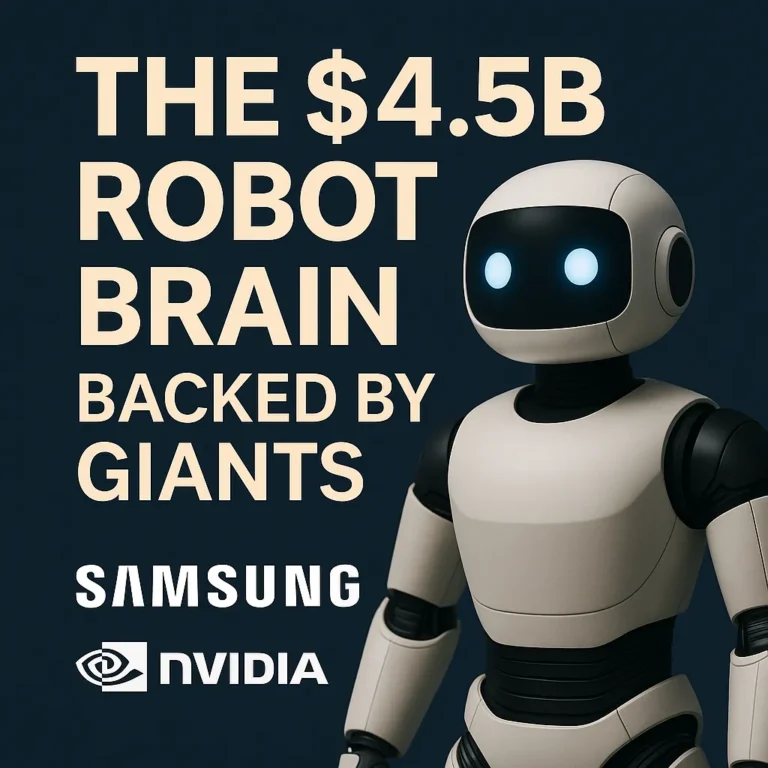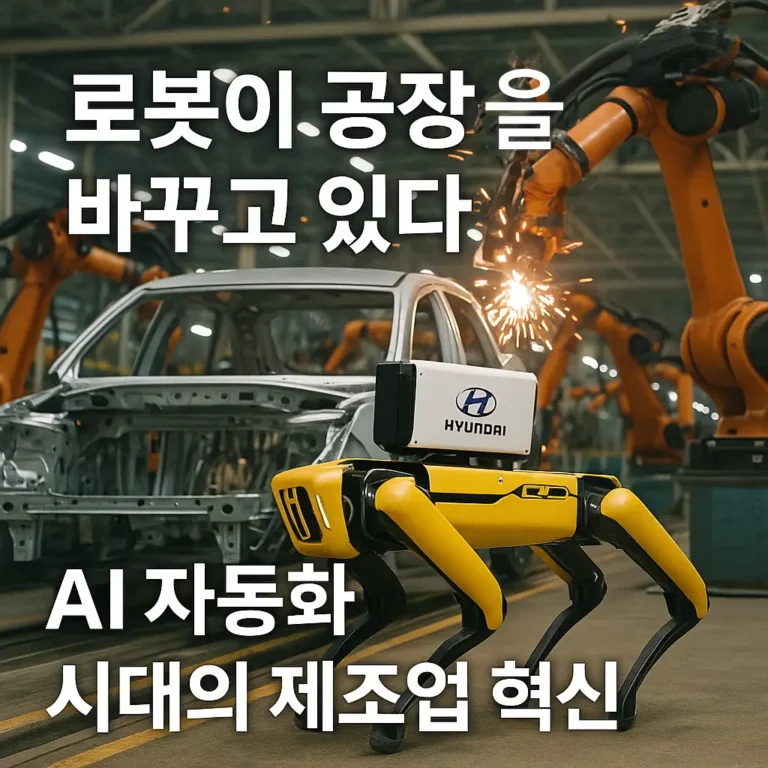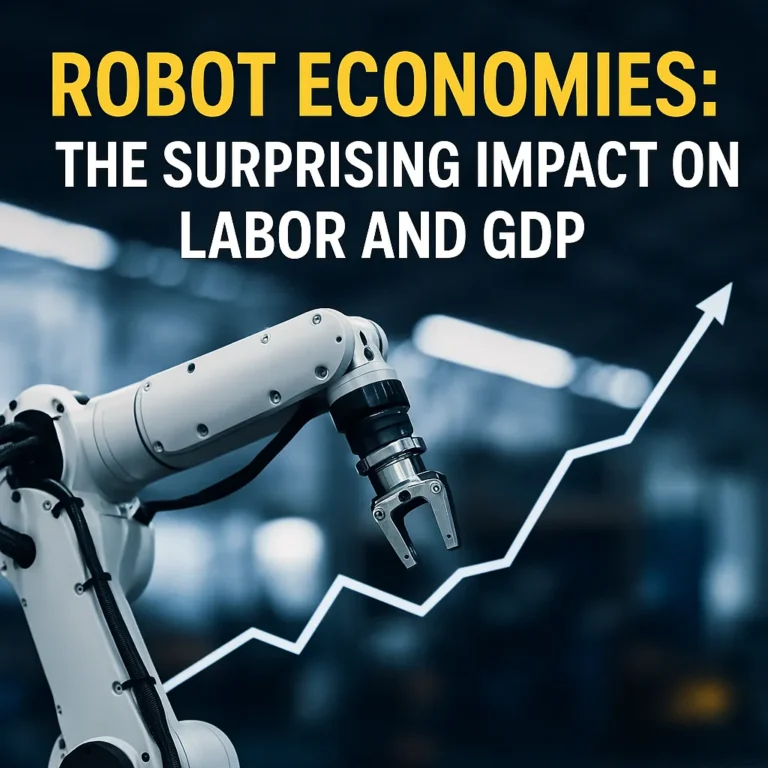Designing Smarter Cities: How AI Is Rewiring Housing, Transit, and Energy
Cities are growing faster than we can build them. By 2030, nearly 5.2 billion people—over 60% of the global population—will live in urban areas, placing immense pressure on infrastructure, housing, transit, and utilities. Traditional urban planning methods are no longer sufficient to meet the demands of speed, sustainability, and complexity. To keep up, cities must become not just “smart,” but intelligent, autonomous, and responsive.
Enter the age of AI-powered urban design. Artificial intelligence is now being embedded into the fabric of city systems—optimizing energy flows, rerouting traffic in real time, predicting housing needs, and managing utilities with precision. This shift marks more than just a technological upgrade—it signals a new economic model for cities: one that rewards data-driven planning, operational efficiency, and resilient infrastructure.
In this blog, we explore how AI is rewiring three pillars of urban life—housing, transit, and energy—to build the foundation for smarter cities. These systems don’t just operate better; they think ahead, adapt in real time, and help cities become more efficient, sustainable, and economically resilient.
Here is the bar graph visualizing projected urban population growth by region from 2020 to 2050, with a callout emphasizing: “By 2030, 5.2 billion people will live in cities.”
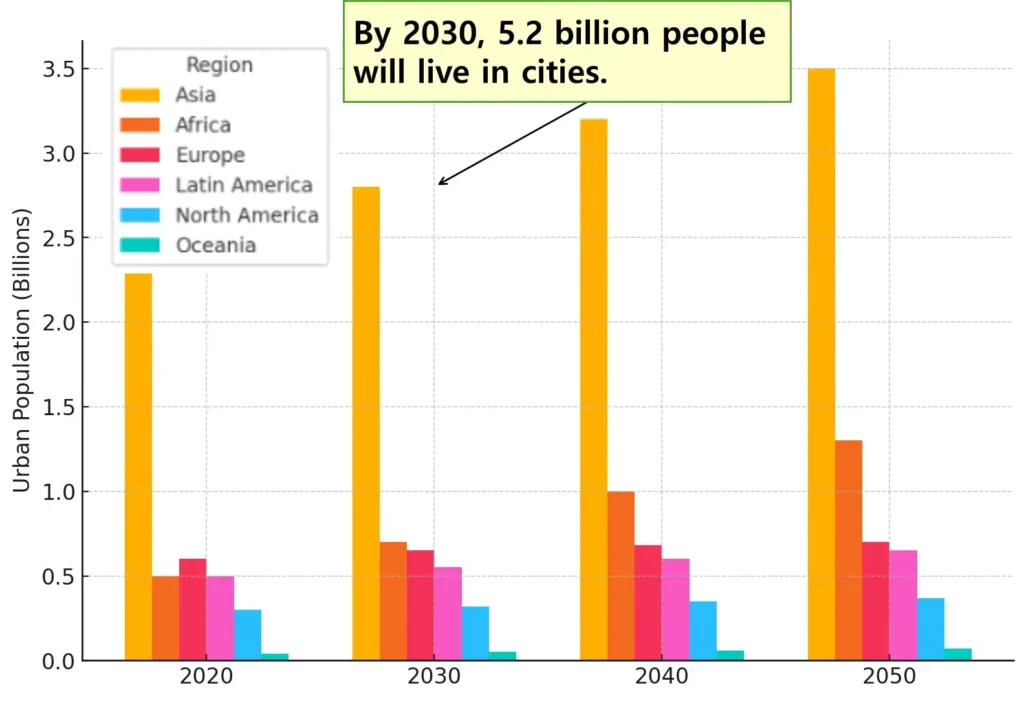
The Tech Stack Powering Smarter Urban Infrastructure
Cities of the future won’t just be built—they’ll be programmed. At the core of AI-driven urban transformation lies a complex, interlocking tech stack that enables cities to collect, process, and act on massive volumes of real-time data. This digital infrastructure is what empowers smart cities to become truly autonomous in managing housing, transportation, energy, and more.
Let’s unpack the core technologies fueling this urban intelligence revolution:
Internet of Things (IoT) Sensors
IoT devices are the sensory layer of AI cities. These include cameras, air quality monitors, traffic counters, smart meters, and building sensors—all feeding continuous data into city systems. For example, Barcelona’s urban IoT network monitors everything from street lighting to waste levels in public bins, enabling automated response.
Machine Learning & Predictive Analytics
Machine learning models analyze urban data to forecast outcomes—predicting traffic surges, energy usage patterns, or housing demand. These predictions aren’t static; they improve over time, helping cities stay agile. In Helsinki, predictive AI helped reduce district heating costs by analyzing weather patterns and usage behavior.
Edge Computing
Unlike traditional cloud-based processing, edge computing enables data analysis to happen close to the source—right at the sensor or device. This minimizes latency, which is crucial for real-time tasks like adaptive traffic signals or emergency dispatch systems.
Digital Twins
A digital twin is a real-time virtual replica of a city or system—capable of simulating everything from building performance to urban traffic. Urban planners use these digital twins to test zoning changes or new transport infrastructure without touching the real world. Shanghai and Singapore are already deploying city-wide twins to model energy flows and public mobility.
Interoperability & Open APIs
For AI to work at city scale, systems must talk to each other. Open APIs and standardized protocols allow different components—like transit platforms, utility meters, and governance dashboards—to connect and share data. This unlocks ecosystem-wide optimization rather than siloed efficiency.

This tech stack is more than just hardware and code—it’s the nervous system of the intelligent city. It turns data into decisions, predictions into policy, and models into movement.
The Economics of Intelligent Cities
As AI systems take root in urban design, their most transformative impact may not be visible—but economic. Intelligent cities don’t just function more efficiently; they unlock measurable cost savings, productivity gains, and new value chains. From infrastructure planning to energy use and mobility services, AI-driven decision-making is emerging as a key economic lever for governments, businesses, and citizens.
Operating Smarter, Spending Less
AI enables cities to automate and optimize core services, reducing both overhead and waste.
- Predictive maintenance of infrastructure can cut repair costs by 10–20%.
- Smart street lighting has reduced electricity usage by up to 70% in cities like Los Angeles.
- Traffic AI systems reduce congestion-related losses, which cost the global economy over $300 billion annually (INRIX, 2023).
Even modest efficiency improvements across sectors can yield compound savings in public spending and improve service delivery outcomes.
Unlocking Trillions in Urban Productivity
According to McKinsey Global Institute, AI-infused urban systems could generate $1.5 to $2.0 trillion in annual economic value by 2035. This value creation spans:
- Energy optimization and smart grids: reduced peak loads and lower emissions fines
- Dynamic mobility pricing: improving usage while maximizing revenue
- AI in real estate: faster permitting, optimized land value, and reduced idle assets
As automation reduces waste, labor and capital can be reallocated to higher-value activities—accelerating innovation, jobs, and growth.
ROI on AI Infrastructure: A Global Snapshot
Cities at the forefront of AI integration are already reporting tangible returns:
- Helsinki cut heating costs by 15% using AI-driven energy demand forecasting.
- Barcelona’s smart infrastructure program saved €75 million in water and energy costs over a five-year period.
- Singapore’s AI-optimized mobility network reduced travel times by 8–15% during peak hours.
These gains aren’t just tech wins—they’re fiscal wins that validate long-term investments in digital infrastructure.
Reducing the Cost of Urban Complexity
The complexity of modern cities—millions of decisions about transport, zoning, utilities—often leads to inefficiencies from bureaucracy, miscoordination, and static planning. AI addresses this by introducing:
- Real-time data harmonization across departments
- Automated resource allocation
- Simulation-driven urban policy testing
In short, AI makes cities more like systems—and less like silos.
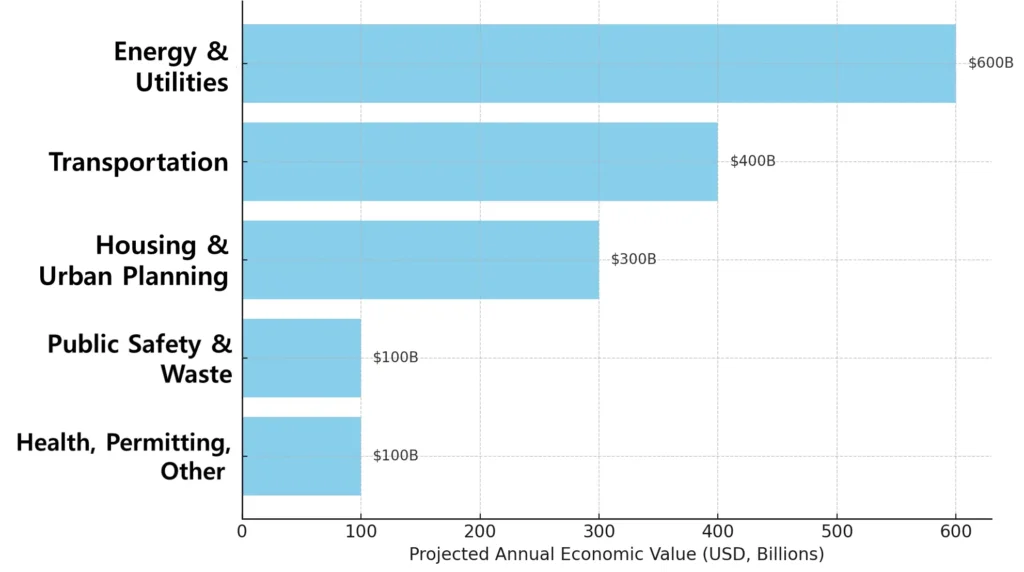
Housing Gets an Upgrade: AI in Zoning, Design, and Development
Housing isn’t just a social necessity—it’s a city’s largest asset class and one of its most complex economic systems. With rising urban populations, land scarcity, and affordability crises across the globe, AI is stepping in as a strategic urban planning tool. From land use simulation to generative building design, AI is reshaping how cities house their people—faster, smarter, and more affordably.
Predictive Zoning and Land Use Optimization
Conventional zoning relies on static maps and slow bureaucratic reviews. AI zoning engines—powered by historical data, demand projections, and spatial analytics—allow planners to simulate dozens of land-use scenarios in seconds.
- Example: Seoul’s AI zoning system helps planners identify underutilized land parcels and suggests rezoning based on forecasted population shifts and infrastructure access.
- Benefit: Reduces planning time by up to 40% and allows more dynamic density adjustments in growing areas.
Generative Design for Cost-Efficient Housing
Generative AI tools allow architects and developers to input constraints (lot size, sunlight, budget, materials) and instantly generate thousands of building layouts optimized for livability and cost.
- Example: Autodesk’s generative design platform has been used in affordable housing projects to reduce structural costs by up to 20%.
- Benefit: Developers save design time and material costs, while governments can enforce sustainability and accessibility standards more consistently.
AI-Powered Permitting and Compliance
Permitting delays often add months to construction timelines. AI platforms can review architectural drawings, check for code violations, and pre-approve permits automatically.
- Example: In California, pilot AI permit review systems reduced approval timelines from 6 months to under 6 weeks in selected cities.
- Benefit: Faster builds mean lower financing costs and earlier occupancy—translating into real economic value for cities and residents alike.
Forecasting Housing Demand with Precision
AI models synthesize census data, migration trends, economic growth forecasts, and even school enrollments to predict future housing needs at the district or neighborhood level.
- This level of accuracy allows cities to better match supply with future demand, avoiding the twin risks of underbuilding or oversupply.
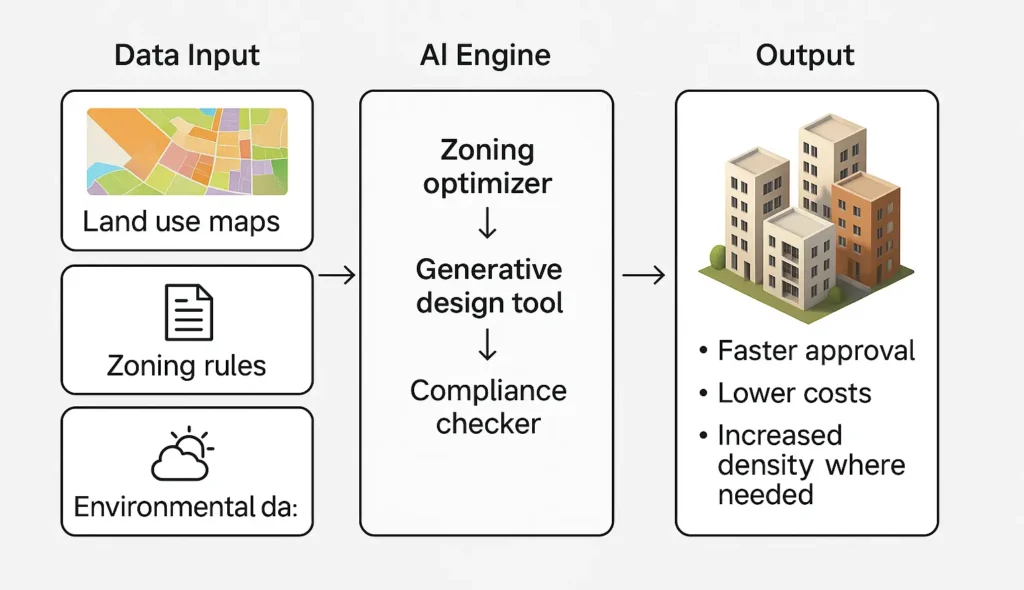
AI isn’t just speeding up housing development—it’s making it adaptive, data-driven, and economically resilient. By cutting friction across planning, design, and compliance, AI helps cities meet housing needs while maximizing land value and ensuring long-term sustainability.
Smarter Mobility: Real-Time Transit, Traffic, and Autonomous Fleets
Transportation is the circulatory system of any city, and inefficiencies here ripple through the economy in the form of lost time, pollution, and logistics delays. AI is transforming urban mobility from a rigid system of fixed routes and static timetables into a dynamic, adaptive, and predictive network. From smart traffic lights to autonomous fleets, AI-powered transportation systems promise faster commutes, lower emissions, and significant operational savings.
Real-Time Traffic Flow Optimization
Traditional traffic signals operate on static cycles that fail under modern urban congestion. AI-enabled systems use real-time sensor data and predictive algorithms to adjust signal timing dynamically.
- Example: Pittsburgh’s Surtrac system cut wait times by 40% and travel time by 25%.
- Economic benefit: U.S. cities lose over $120 billion annually due to congestion; even a 10% improvement translates into billions in savings.
AI-Powered Public Transit Routing
AI can analyze historical ridership, event calendars, traffic data, and even weather to propose on-demand bus routes and adaptive scheduling.
- Example: In Singapore, AI adjusts bus frequencies in real time based on passenger density and congestion.
- Result: Fewer empty buses, reduced operational costs, and better service for riders.
Autonomous Mobility and Shared Fleets
Autonomous vehicles (AVs), powered by real-time object detection and AI decision engines, are beginning to replace conventional ride-hailing and transit.
- Cities like San Francisco, Beijing, and Dubai now pilot robotaxi services with full autonomy in geofenced areas.
- Shared AV fleets can reduce car ownership by 40–60%, freeing up urban land used for parking.
Predictive Maintenance for Transit Assets
AI models continuously monitor buses, trains, and infrastructure—alerting operators to pending breakdowns before they happen.
- Benefit: Fewer delays, safer transit, and extended asset life cycles.
- Economic gain: Predictive maintenance can cut unplanned downtime by up to 50%, according to Siemens.
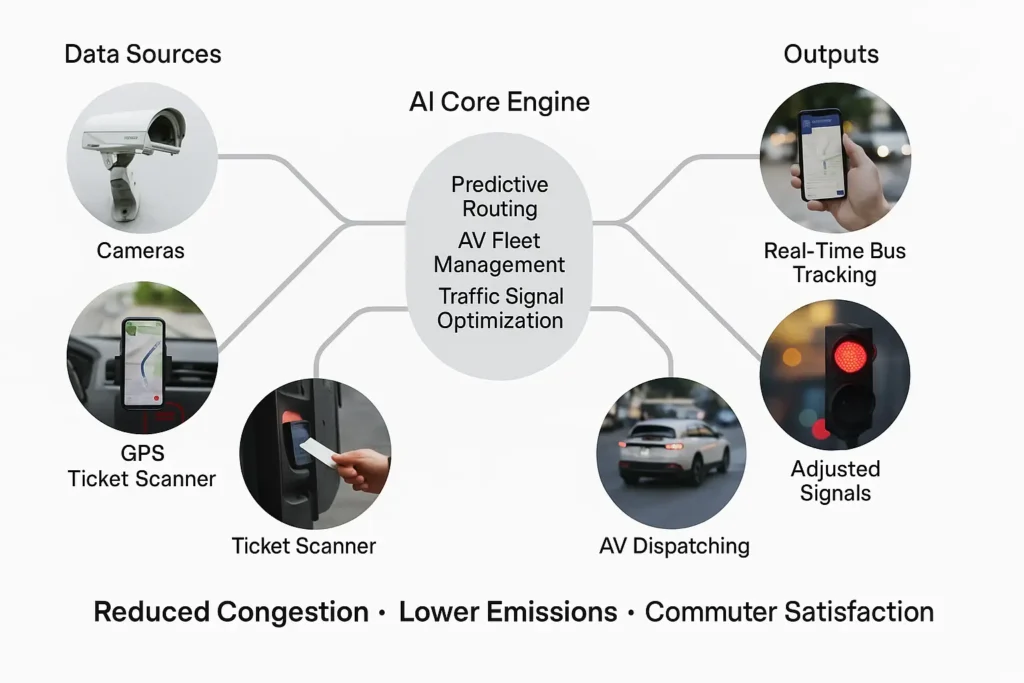
This diagram captures how AI transforms transportation into a closed-loop, responsive ecosystem that improves efficiency, sustainability, and user experience simultaneously.
Rewiring Energy and Utilities for Resilience and Sustainability
Urban energy systems were never designed for the complexity of today’s cities. With demand peaks, climate shocks, and renewable integration, utility networks are under strain. AI offers a real solution—not just for optimization, but for building resilient, adaptive, and low-carbon energy infrastructures.
Smart Grids with Predictive Intelligence
Traditional energy grids operate reactively. AI-enabled smart grids, on the other hand, anticipate consumption spikes and dynamically balance loads using real-time data from smart meters and distributed energy sources.
- Example: The UK’s National Grid partners with Google DeepMind to forecast energy demand 24 hours in advance with over 90% accuracy, allowing smoother energy dispatch and fewer emergency reserves.
- Impact: Reduces operational costs and reliance on fossil backups—saving money and emissions.
Integrating Renewable Energy at Scale
Solar and wind are inherently variable. AI models optimize their integration by predicting generation patterns and coordinating battery storage, backup systems, and demand response programs.
- Example: In California, AI forecasts solar availability down to the neighborhood level, adjusting supply loads across districts.
- Benefit: Higher grid reliability and 20–30% greater efficiency in clean energy use.
Utility System Automation and Maintenance
AI continuously monitors the health of utility infrastructure—like water pipelines, substations, and transformers—through sensor data and anomaly detection.
- Outcome: Early warnings for leaks, surges, or breakdowns, avoiding costly failures.
- Example: New York City’s smart water monitoring system detects leaks with 95% accuracy, reducing waste and repair costs.
Demand Forecasting and Dynamic Pricing
AI predicts household and district-level demand, enabling dynamic pricing models that shift usage away from peak hours.
- Consumers benefit through cost savings; cities reduce strain on infrastructure.
- Power providers can better manage distributed energy systems and avoid blackouts.
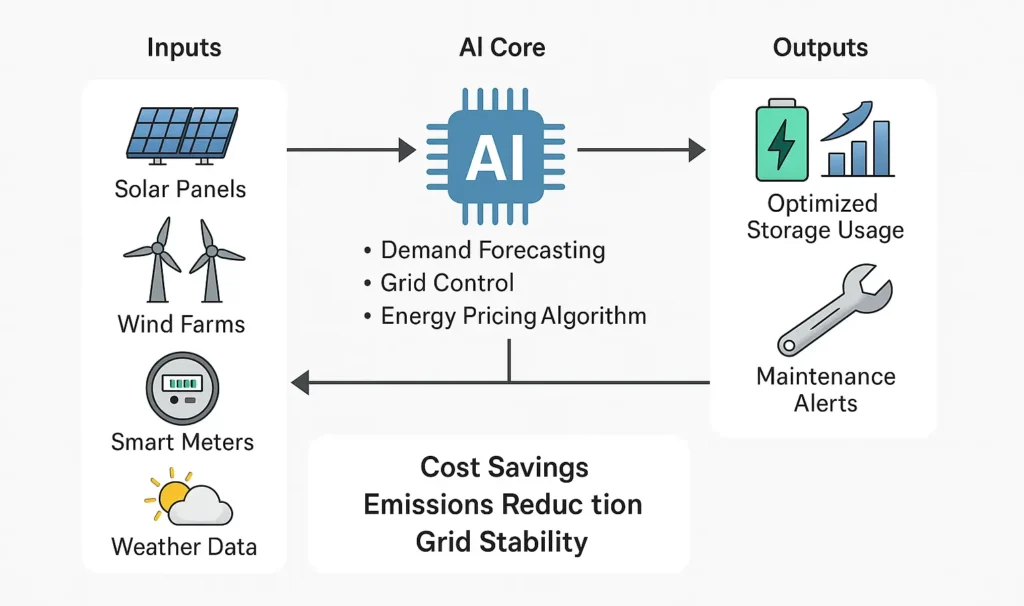
In AI-powered energy systems, waste becomes signal, and data becomes power—literally. Cities that adopt these technologies stand to gain not only cleaner air and stable grids, but also millions in annual cost savings through predictive maintenance, dynamic control, and smarter demand management.
Global Case Studies: Leading AI Cities in Action
While the vision of AI-powered cities may sound futuristic, several governments and developers are already building and operating functioning AI cities. These urban hubs are using data and automation to improve quality of life, reduce emissions, and unlock massive economic value—all while setting blueprints for others to follow.
Singapore: AI as the Operating System of the City
Singapore is widely regarded as a global leader in smart governance. Its Smart Nation initiative embeds AI across sectors—from dynamic tolling to energy-efficient housing blocks.
- Mobility: Predictive models adjust bus frequency in real time, reducing wait times by 10–15%.
- Energy: Smart meters and AI-driven cooling systems have helped slash electricity use in public housing by up to 30%.
- Governance: The city operates an AI chatbot (“Ask Jamie”) across 70+ government portals, handling citizen queries and reducing call center costs.
✅ ROI: Estimated annual savings exceed $500M across energy and transport sectors.
NEOM (Saudi Arabia): AI City From the Ground Up
NEOM is a $500 billion experimental megacity under construction—designed to operate entirely on renewable energy and autonomous systems.
- Design: Uses AI-generated urban layouts to minimize land use and prioritize walkability.
- Energy: Every building is digitally twinned and monitored for energy efficiency in real time.
- Security: AI surveillance and predictive analytics shape law enforcement and disaster response protocols.
✅ Significance: NEOM offers a preview of how cities could be built AI-native from day one.
Helsinki: AI for Transparent Urban Management
Helsinki prioritizes ethical AI integration. It runs one of the world’s first open AI registries, allowing citizens to see how AI is used in municipal operations.
- Heating: Predictive AI in district heating reduces consumption by up to 15% during peak seasons.
- Urban Planning: Digital twins simulate zoning and traffic policies before implementation.
- Trust: Residents have access to all models, data sources, and decision rules used in the city’s AI tools.
✅ Outcome: Increased public trust and improved planning accuracy at reduced cost.
Barcelona: Optimizing Infrastructure with AI and IoT
Barcelona transformed itself into a smart city through sensor networks, AI analytics, and citizen-centric digital platforms.
- Waste Management: AI predicts waste bin fill levels, optimizing collection routes and saving 25% in fuel and labor costs.
- Water & Energy: Smart irrigation systems reduce water usage by 30% in public parks.
- Public Engagement: The city’s Decidim platform lets citizens vote on infrastructure AI projects.
✅ Savings: Over €75M saved in utility and service optimization over five years.
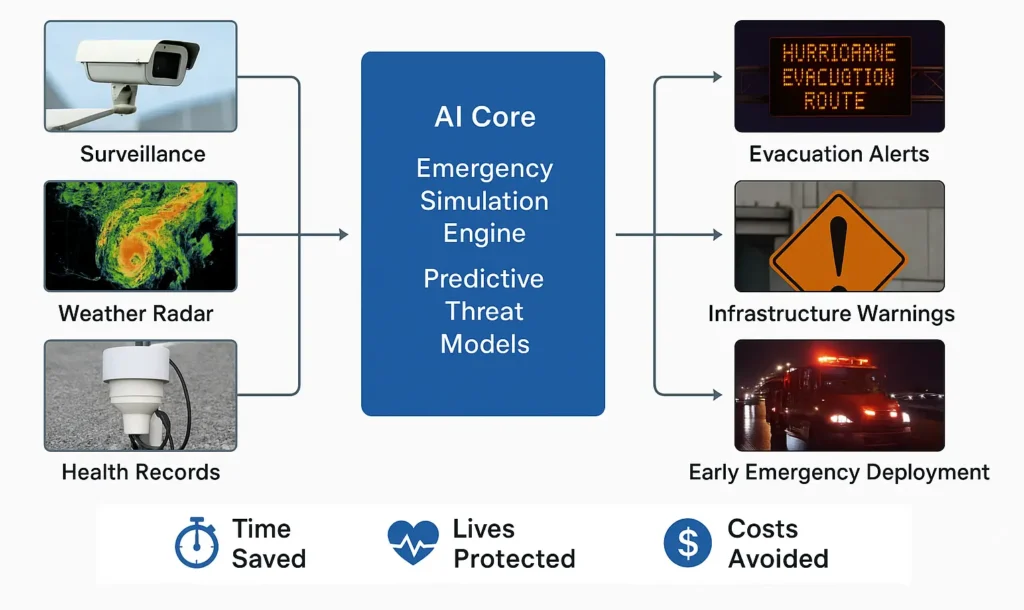
AI doesn’t just make cities smarter—it makes them safer and stronger. By anticipating threats and accelerating response, AI systems give cities the resilience edge they need to face the 21st century with confidence.
Conclusion: Designing the Future—One Algorithm at a Time
We’re entering an era where cities are not just planned and built—they are continuously optimized, monitored, and self-corrected. Housing, mobility, and energy—three of the most resource-intensive pillars of urban life—are now being reimagined through the lens of artificial intelligence. And with that comes not only new efficiencies, but new possibilities.
AI doesn’t just help cities work better. It helps them think ahead—anticipating traffic surges before they happen, adjusting power flows to match solar intensity, rerouting waste collection based on fill levels, and recommending zoning changes in line with future growth. These aren’t one-time upgrades; they are adaptive loops of intelligence that make our cities more liveable, resilient, and economically viable over time.
But with this power comes responsibility.
The most successful AI cities don’t just automate—they govern transparently, engage citizens, and invest in human capital. They make sure the benefits of efficiency don’t come at the cost of equity. They recognize that AI is not just a tool, but a design philosophy—a commitment to continuous improvement, data-driven policy, and systems that respond in real time to the people they serve.
✅ Key Takeaways
- AI isn’t theoretical—cities like Singapore, Helsinki, and Barcelona are saving millions through smarter housing, transit, and energy systems.
- Economic ROI is real—AI-powered urban systems could unlock up to $2 trillion annually by 2035.
- Equity and trust must guide design—transparent algorithms and upskilled labor are as important as the technologies themselves.
- The future of urban life isn’t about concrete or code alone. It’s about designing adaptive systems that respond to data—and to people.
🚀 Final Thought
The cities that lead tomorrow won’t be the ones that simply adopt AI—they’ll be the ones that design around it. The question is no longer if AI will shape our cities. It’s how well we shape AI to serve them.
📚 References
- McKinsey Global Institute (2018).
“Smart Cities: Digital Solutions for a More Livable Future.”
https://www.mckinsey.com/business-functions/sustainability/our-insights/smart-cities - PwC (PricewaterhouseCoopers) (2021).
“AI in the Public Sector: Smart Solutions for Smart Cities.”
https://www.pwc.com/gx/en/issues/analytics/assets/pwc-ai-public-sector.pdf - World Economic Forum (WEF) (2020).
“Jobs of Tomorrow: Mapping Opportunity in the New Economy.”
https://www.weforum.org/reports/jobs-of-tomorrow - INRIX Global Traffic Scorecard (2023).
“The Global Economic Cost of Congestion.”
https://inrix.com/scorecard - City of Helsinki – AI Register (2023).
“Transparency in Artificial Intelligence Usage.”
https://ai.hel.fi - Google DeepMind × National Grid UK (2020).
“AI Energy Forecasting in the UK Grid.”
https://deepmind.com/blog/article/machine-learning-can-boost-the-efficiency-of-wind-energy - Sidewalk Labs (2019).
“Generative Design for Urban Housing.”
https://www.sidewalklabs.com/reports/generative-design-tool - Smart Nation Singapore (2024).
“Public Sector AI Projects Overview.”
https://www.smartnation.gov.sg - NEOM Official Site (2024).
“NEOM: The World’s First Cognitive City.”
https://www.neom.com/en-us - Siemens City Performance Tool (2020).
“Predictive Maintenance and Grid Optimization.”
https://www.siemens.com/global/en/home/company/topic-areas/future-of-cities/smart-infrastructure.html
🔑 Keywords
- AI cities
- smart city infrastructure
- urban planning with AI
- AI in housing design
- AI in transportation systems
- smart mobility solutions
- AI-powered energy systems
- urban sustainability with AI
- real-time city optimization
- economic impact of smart cities
- autonomous city systems
- generative zoning AI
- predictive urban planning
- AI in public utilities
- future of smart cities
- digital twin urban planning
- AI in disaster management
- civic tech and AI jobs
- city automation and governance
- intelligent urban design
